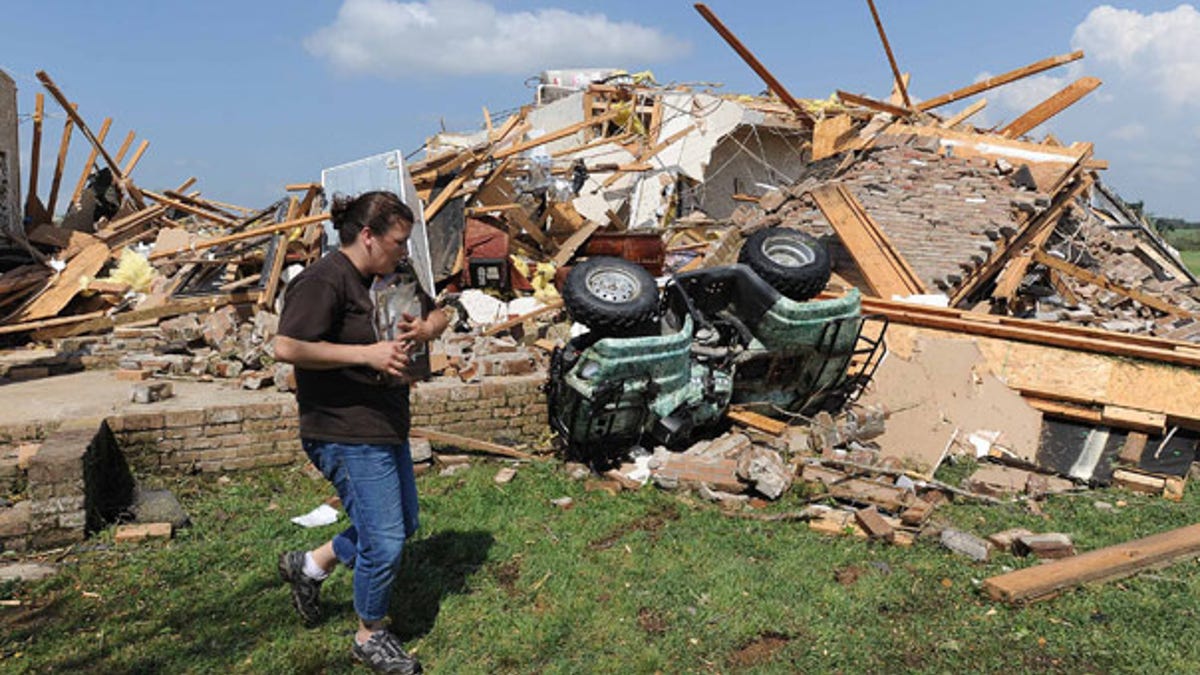
April 24: A woman helps her friend recover photos after a tornado swept through Holmes County, Miss. (AP)
Survivors of the series of deadly tornadoes that have swept the U.S. in the past week have had first-hand experience with their shocking and intense power.
Indeed, tornadoes are so rapid and forceful the body may not have time to adjust to the pressure drop, experts told FoxNews.com. Within their vortex, a vacuum effect occurs -- and the negative pressure and upward winds can literally suck the air right out of people's lungs.
“It would be impossible for the person to draw in breath -- and if this lasts longer than three minutes it could prove fatal,” pulmonary specialist Dr. Len Horovitz told FoxNews.com.
Other dramatic tales of death and survival bear witness to the tornado's powerful might.
Catherine Hamil tried desperately to protect her children, huddling in a bathtub covered by a mattress in Piedmont, Okla. The great force of the twister ripped them from her arms, killing her two sons, Ryan, 3, and Cole, 15 months. Catherine and her daughter Cathleen, 5, were injured but are expected to be okay.
Recent high school graduate Will Norton was ripped from a Hummer H3 through the vehicle's sunroof on Sunday after a tornado pummeled Joplin, Mo. His father held tight to Will, but the force was too strong -- he is still missing.
Rob Pace, an executive at St. John’s Regional Medical Center in Joplin, experienced 15 minutes of sheer terror as he was thrown about like a rag doll when a tornado hit the building.
Storm chaser Chris Novy found himself helpless in the vortex of a tornado. The vehicle in front of his was aggressively pulled from one side of the street to the other; his own car was lifted off the ground, then dropped -- repeatedly.
Tornadoes have shaken the nation, causing destruction in a matter of moments. But what is it that makes them so destructive?
Tornadoes are formed when cold, dry air masses and warm, moist air masses meet, creating instability in the atmosphere. The United States is the most tornado prone region in the world because it sits perfectly between the two ingredients it needs: cold air from Canada and warm air from the Gulf of Mexico.
These deadly twisters also need wind shear -- strong winds that have the ability to change speed and direction quickly -- and a jet stream. These high winds in the air are able to come down to the surface, creating the forceful effect of tornadoes.
It is these winds that can reach speeds greater than 200 mph that have the ability to “break apart a house, lift people in the air and create debris which can kill people” said Don Burgess, research scientist at the University of Oklahoma who is affiliated with the National Severe Storms Lab.
There are nevertheless limits to what a tornado can do. Films like "Twister" show them hurling cars and trucks about like toys. And while possible, that's rare, explained Dr. Josh Wurman, President of the Center for Severe Weather Research
"Now, there are some rare cases of cars way up in the air in some very strong tornadoes…but usually they’re bouncing around near the ground.
It's rare because “just because the winds that it would take to keep a car up in the air probably just don’t happen very often, even in these strong tornadoes. It’s very very rare that you would get enough wind to keep the car up in the air for more than a second or two,” said Wurman.




















